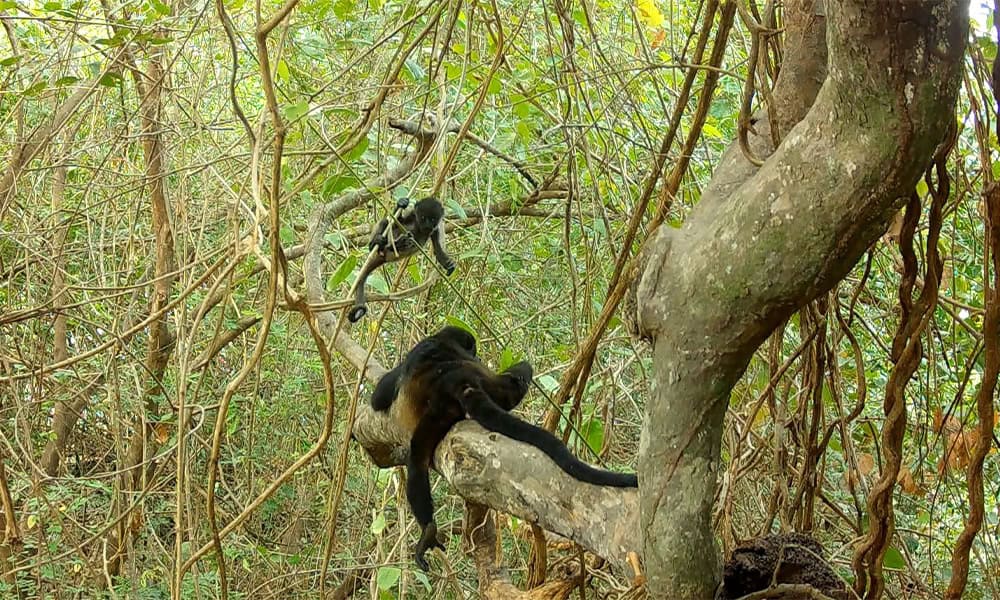This morning, as I sat in my sweaty little office being slow-roasted by an incorrectly vented clothes dryer, my task, as it often is, was to review a couple hundred wildlife videos and enter information from each video into a database. It’s a repetitive, seemingly tedious task that for some reason I have no problem with. I sit at my computer with my feet on a dog, I put on a podcast and type away.
The project I was working on consisted of a few camera traps on a private coastal farm where I’ve had the good fortune to work for several years now. Over the years, I’ve moved cameras all around the property. I’ve had cameras on trails. Cameras overlooking streams. I pointed a camera at big hole in a tree and monitored it for over a year.
For a while, I had camera on the base of a tree that stuck out horizontally from the top of a cliff overlooking the ocean where, even though I felt like I could possibly tumble off the cliff every time I reviewed the camera, it was well worth it because I recorded a bunch of videos of ospreys eating fish amongst the branches.
My current favorite camera location on the property is approximately three and a half meters above a creek in a tree. I chose the general location because I had already recorded a wide variety of species at ground level in and around the stream and I was interested to see what was happening up above in the branches.
The trick was finding a suitable tree. For me, a suitable tree is one that I can climb using my climbing spikes – bent pieces of metal with a screw on one end that I can screw into the tree and climb up. Though I suppose any tree could be climbed in this fashion, I only climb trees that appear to have a good place for a camera at a height low enough that my wife and mom wouldn’t yell at me if they saw me up there.
This tree had the perfect spot, a nice wide horizontal branch with no small branches or leaves that would blow in the wind and constantly trigger the camera. I aimed the camera at the branch and waited for the parade of arboreal species that would surely pass by. After two months, the results were surprisingly unspectacular. I recorded a mouse, a tree frog, a few birds and mammals, but that was it.
I decided to move the camera a little higher into the same tree, this time facing a curved branch that was surrounded by a tangle of vines. I expected that the vines would blow in the wind and fill my SD card with videos of nothing. However, I had just climbed up and down a mountain and I was too tired to find another a tree, so that spot was good enough.
After 432 days, that camera is still in the exact same spot because it keeps on giving me camera trap gold. It has recorded 1,185 videos of 22 species including 12 mammals, 8 birds, 1 reptile, and 1 amphibian. It has recorded two species of monkeys, mantled howler monkeys and white-faced monkeys, but I frequently recorded them in other trees on the property. What made this location special was the species that I have very little luck recording like kinkajous, Mexican hairy porcupines, and Central American woolly opossums. At this point, the majority of the videos that I’ve ever recorded of those three species are from this tree.
It’s incredible to me the vast difference in the number of species that you can record in one spot versus a spot a few meters away on the same tree. Other trees on the same property haven’t had similar results. A different branch on the same tree had wildly different results. I’ve come to realize that the tangle of vines around the branch that I would normally avoid because of movement in the wind is the reason all of the species were there. They were using the vines to gracefully move amongst the trees.
I’ve selected a few of my favorite videos from this camera so you can get a feel for the biodiversity of one branch on one tree in Costa Rica. Enjoy.
About the Author
Vincent Losasso, founder of Guanacaste Wildlife Monitoring, is a biologist who works with camera traps throughout Costa Rica. Learn more about his projects on facebook or instagram. You can also email him at: vincent@guanacastewildlifemonitoring.com






